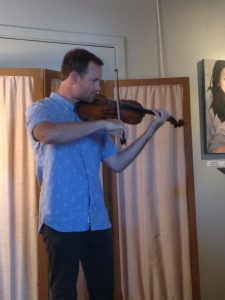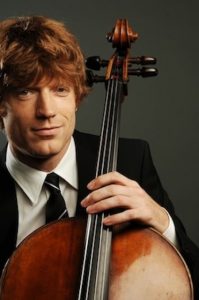Sunday in the Park with the Carlsbad Music Festival
Sunday at the Carlsbad Music Festival verged on offering something for everyone, with juxtapositions of musical style appearing like the flashing colored lights in a classic pinball machine. After a pulsing outdoor show by FAZI, a visiting Chinese rock band, we moved to St. Michael’s Chapel for two hours of J. S. Bach for solo violin.
After swooning to soprano Michelle Law’s arias by Wagner and Verdi, we encountered avant-garde pieces for cello, and then with Nathan James’ wailing R & B ballads—accompanied on his handcrafted washboard guitar—still ringing in our ears, we settled down to the whimsy and quiet plinks of Scott Paulson’s toy pianos.
For all of this variety, Artistic Director Matt McBane has maintained a consistently high level of performance. Every Carlsbad Music Festival act upholds a remarkably high standard for its genre, although I must confess my experience of Chinese rock bands is scant, so I am taking that group’s performance on faith.Eric Byers’ solo cello recital at Carlsbad Inn’s Village Terrace gracefully embraced two of the festival’s more disparate musical styles, opening with J. S. Bach’s iconic Cello Suite No. 1 in G Major and contrasting it with four recent cello compositions filled with an array of extended techniques and even some simultaneous singing by the cellist. Byers’ serene command of his instrument made comfortable neighbors of these antipodal approaches to the cello.
He projected the buoyant figuration the Bach Suite’s Prelude with a confidence that artfully balanced the composer’s improvisatory intention with its insistent metrical foundation, shaping the movement with adroit dynamic contrasts. In the dance movements that followed, Byers discovered the core motifs that defined each dance; then, with sensitive articulation, he crafted these motifs into mesmerizing sonic structures.
Of the newer works, Finnish composer Kaija Saariaho’s arresting “Sept Papillons” (“Seven Butterflies”)
from 2000 proved the most inventive. Each miniature featured a different combination of fluttering harmonics, scrapings, or taps on the body of the cello that could be interpreted either as sonic abstractions or as descriptive as her title appears to imply. John Luther Adams’ “Three High Places” (2007) also stimulated the listener’s imagination, suggesting the title’s remote landscapes with his languorous, low-pitched lines punctuated by flickering harmonics.Intense, slightly grating oscillating figures, sextuplets I believe, that formed a breathless moto perpetuo in the cello’s low range would be an apt description of Matt McBane’s “Linear Arithmetic,” which Byers premiered with uninhibited flair. Italian composer Giovanni Sollima’s “Lamentatio” (1998) employed more traditional bowing techniques and invoked the modes and cadences of rustic traditional music from central Europe. In the work’s slow sections, the cellist added a slightly nasal vocalise, which dropped out in the agitated, dervish-suggesting sections.
A founding member of the respected Calder Quartet, Byers has a long association with the Carlsbad Music Festival, both as a member of the quartet and as a soloist. While I have missed the quartet’s participation in the festival in more recent years, Byers presence is worthy compensation.
To conclude the 2018 Carlsbad Music Festival, Johnny Gandelsman performed all six of J. S. Bach’s extensive solo works for unaccompanied violin—the three partitas and the three sonatas. Playing from memory with astounding concentration, unfailingly beautiful tone, and scrupulous attention to detail at every tempo, Gandelsman transfixed the audience in St. Michael’s Chapel.
Gandelsmann explained that he gives these Bach recitals without intermission because the interval destroys the audience’s engagement with the music, and it takes too long to re-establish it when folks return form the break.
Each of the Sonatas contains a fugal movement, and Gandelsmann delivered these complex contrapuntal conundrums with startling motivic and structural integrity, a feat for an instrument that was designed to play but a single line. His gentle Sarabandes, in the B Minor Partita and the D Minor Partita, became exquisite, heart-melting sighs, and his brisk Correntes sparkled with immaculate clarity. The famous Ciaccona from the D Minor Partita unfolded with explosive majesty, and the rhapsodic phrases of the A Minor Sonata’s opening Grave bristled with scintillating ornamentation.
Gandelsmann’s passion for this repertory, his technical fluency, and his interpretive insight elevated this recital to that spiritual level to which every sacred space aspires, but few rarely achieve: an inspiring conclusion to a spectacular festival.
The Carlsbad Music Festival, August 24-26, 2018, was presented on the campus of St. Michael’s-by-the-Sea Episcopal Church in Carlsbad and in several adjacent locations in Carlsbad’s city center. The performances in this review were heard on Sunday, August 26, 2018.

Ken Herman, a classically trained pianist and organist, has covered music for the San Diego Union, the Los Angeles Times’ San Diego Edition, and for sandiego.com. He has won numerous awards, including first place for Live Performance and Opera Reviews in the 2017, the 2018, and the 2019 Excellence in Journalism Awards competition held by the San Diego Press Club. A Chicago native, he came to San Diego to pursue a graduate degree and stayed.Read more…


